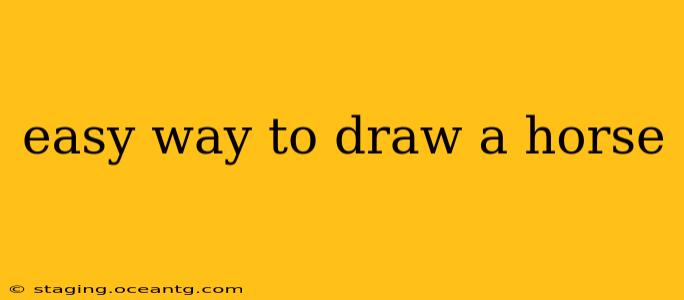Learning to draw a horse can seem daunting, but with a simple approach and the right techniques, even beginners can create a recognizable and pleasing image. This guide breaks down the process into manageable steps, focusing on fundamental shapes and proportions. We'll build confidence and skill, making the seemingly complex task of drawing a horse surprisingly easy.
Understanding Basic Horse Anatomy
Before we start drawing, let's briefly touch upon some key aspects of a horse's anatomy that will make our drawing more realistic:
- Head: Think of the horse's head as a slightly elongated oval. The muzzle is a smaller oval attached to the larger one. The ears are pointed and sit atop the head.
- Body: The body is essentially a large, slightly curved rectangle. The back slopes gently downward.
- Legs: Horse legs are long and slender, with joints clearly defined. Think of cylinders connected by slightly angled joints.
- Tail: A horse's tail is long and bushy, typically starting near the end of the hindquarters.
Step-by-Step Drawing Guide
Now, let's move on to the drawing process itself. Remember, practice makes perfect! Don't be afraid to make mistakes; they're part of the learning process.
Step 1: Sketching the Basic Shapes
Start with simple shapes to form the foundation of your horse. Use light pencil strokes so you can easily erase and adjust later:
- Head: Draw an elongated oval for the head, and a smaller oval for the muzzle.
- Body: Add a large, slightly curved rectangle connected to the head to represent the body.
- Legs: Sketch four long, slender cylinders for the legs, keeping in mind their positions relative to the body. Don't worry about perfect proportions yet.
- Tail: Add a curved line to indicate where the tail will be.
Step 2: Refining the Shapes
Now, let's refine the basic shapes we've created:
- Connect the Shapes: Smoothly connect the head, body, and legs, creating a more fluid outline.
- Add Details: Begin adding details to the head, including the eyes, nostrils, and mouth.
- Legs and Hooves: Shape the legs, adding slightly curved lines to create the joints, and add small ovals for the hooves at the end of each leg.
- Tail: Expand the tail line to create a full, bushy tail.
Step 3: Adding Details and Refinement
At this stage, we add more details to bring our horse to life:
- Muscles and Curves: Lightly sketch in the suggestion of muscles along the neck, shoulders, and hindquarters. Horses have a graceful, muscular build. Subtle curves and shadows will add to the realism.
- Mane and Forelock: Draw the horse's mane and forelock. These are typically long and flowing.
- Ears: Make sure the ears are correctly positioned and add fine details.
- Erase Unnecessary Lines: Gently erase any unnecessary construction lines from previous steps.
Step 4: Shading and Finishing Touches
Adding shading will give your horse a three-dimensional look:
- Light Source: Decide where your light source is coming from and add shadows accordingly. This will help define the form and muscles of the horse.
- Blending: Use shading techniques like hatching or cross-hatching to create depth and texture.
- Final Touches: Add any finishing touches you want, such as a background or additional details.
Frequently Asked Questions (FAQ)
What materials do I need to draw a horse?
You'll primarily need a pencil (a range of hardness, such as HB and 2B, is beneficial), an eraser, and paper. A sketchbook is ideal, but any paper will do.
How do I draw a horse's legs correctly?
Focus on the cylindrical nature of the legs and the angular joints. Observe real horse photos or videos to understand the placement and articulation of the legs. Start with simple lines and gradually add details.
How do I draw a horse's head?
Begin with the basic oval shapes for the head and muzzle, then add the eyes, nostrils, and mouth. Notice the subtle curves and angles of a horse's head. Refer to images for guidance.
What if my horse drawing doesn't look perfect?
Drawing takes practice. Don't get discouraged if your first attempt isn't perfect. Keep practicing, and you'll gradually improve. Experiment with different techniques and styles.
Are there any online resources or tutorials available to help me?
Yes, numerous online resources, including YouTube tutorials and drawing websites, offer step-by-step instructions and helpful tips for drawing horses. These resources can supplement this guide and provide additional perspectives.
By following these steps and practicing regularly, you’ll soon be able to draw your own horses with ease and confidence. Remember, it’s all about learning the basic shapes and then adding details gradually. Have fun and enjoy the process!
